| Date | Text | |
|---|---|---|
29 Jul 1507
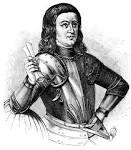
Martin Behaim |
death Martin Behaim Martin Behaim, German navigator and geographer (born 1459) |
|
29 Jul 1573

John Caius |
death John Caius Died 29 Jul 1573 at age 62 (born 6 Oct 1510). Prominent humanist and physician whose classic account of the English sweating sickness is considered one of the earliest histories of an epidemic. |
|
29 Jul 1796

Walter Hunt |
birth Walter Hunt Born 29 Jul 1796; died 8 Jun 1859 at age 62. American inventor who designed the first repeating rifle. Hunt began inventing in his late teens with a machine to spin flax, which he patented in 1826. He also invented a fire engine gong (1827), a forest saw, a stove that burned hard coal and paper collars. In 1834, he invented a sewing machine with a lock stitch, which he failed to patent until it was too late. Although his inventions were worthwhile, he failed to market them effectively. In 1849, Hunt made the first safety pin out of a piece of brass wire about eight inches long, coiled at the center and shielded at one end. He patented this invention as a “dress pin”, and sold the rights to it for $400. His rifle design of 1849 had a tubular magazine beneath the barrel used with his previously-patented self-propelled “rocket” ball ammunition. |
|
29 Jul 1857

Charles-Lucien Bonaparte |
death Charles-Lucien Bonaparte Died 29 Jul 1857 at age 54 (born 24 May 1803). French zoologist (Prince) who was a nephew of Napoleon Bonaparte. From 1822 to 1828, he was in the United States, where he wrote four volumes of American Ornithology (1825-33) adding to the body of work left unfinished by Alexander Wilson at his death. Bonaparte's scientific reputation was established by these volumes, with which he had the assistance of the artist Titian Peale, who found and painted birds for him from the Rocky Mountains and Florida. In 1848-49, Bonaparte's scientific career experienced a brief hiatus when he took part in the political agitation for Italian independence against the Austrians and he was forced to leave Italy in July 1849. He went to Holland and then to France. |
|
29 Jul 1857
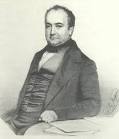
Charles Lucien Bonaparte |
death Charles Lucien Bonaparte Charles Lucien Bonaparte (born 1803), French naturalist. |
|
29 Jul 1862

Eduard Brückner |
birth Eduard Brückner Born 29 Jul 1862; died 20 May 1927 at age 64. German climatologist who also studied the glaciers of the Alps and particularly the effect of the ice ages on the Earth's surface features. By analyzing direct and indirect observations of climatic fluctuations, in pioneering research, he discovered the 35-year Brückner climatic cycle (1887) of swings between damp-cold and warm-dry conditions. He initiated scientific debate on whether climate change should be interpreted as a natural function of the Earth system, or whether it was influenced by man's activities, such as deforestation. He considered the impact of climate change on the balance of power between nations and its economic significance in agricultural productivity, emigration, river transportation and the spreading of diseases. |
|
29 Jul 1868

John Elliotson |
death John Elliotson Died 29 Jul 1868 at age 76 (born 29 Oct 1791). English physician who advocated the use of hypnosis in therapy and who in 1849 founded a mesmeric hospital. He was one of the first teachers in London to emphasize clinical lecturing and was one of the earliest of British physicians to urge use of the stethoscope, together with the methods of examining the heart and lungs which are used to this day. In 1823 acupuncture was mentioned in the first edition of the Lancet and in 1824 Dr. Elliotson began to use this method of treatment. In 1827 he published a series of results on the treatment of forty-two cases of rheumatism by acupuncture. In 1834 he became physician to the University College Hospital, where his interest in hypnosis led to conflicts with the hospital's medical committee and his resignation in 1838. |
|
29 Jul 1870

Asphalt |
Asphalt In 1870, America's first asphalt pavement was laid in Newark, N.J. Previously, coal tar was used for many pavements laid in the 1860s. The first recorded asphalt pavement in the U.S. was a sand mix placed in front of the City Hall in Newark, N.J., in 1870. Edmund J. DeSmedt, a Belgian chemist (who became the inspector of asphalt and cements for the District of Columbia) held a U.S. patent for this asphalt paving method, granted on 31 May 1867. In that century most roads, even in cities, were wide dirt pathways, severely affected by weather. Smooth surfaced asphalt roads originally were for the benefit of bicyclists. By 1904, only 141 miles were surfaced, but commonplace by 1916. Natural asphalt deposits were originally used, but almost all of the asphalt used commercially is now made from petroleum. |
|
29 Jul 1877

William Beebe |
birth William Beebe Born 29 Jul 1877; died 4 Jun 1962 at age 84. Charles William Beebe was an American biologist, explorer and writer on natural history who combined careful biological research with a rare literary skill. As director of tropical research for the New York Zoological Society from 1919, he led scientific expeditions to many parts of the world. Theodore Roosevelt took his advice on the conservation of species and environment. He was the coinventor of the bathysphere, a spherical diving-vessel for use in underwater observations. In 1934, with Otis Barton, he descended in his bathysphere to a then record depth of 3,028 feet (923 metres) in Bermuda waters on 15 Aug 1934. Later dives reached depths of around 1.5 km (nearly 1 mile). He was a mentor to Rachel Carson. |
|
29 Jul 1890

Micrometer screw guage patent |
Micrometer screw guage patent In 1890, Laroy Sunderland Starrett received a U.S. patent for his micrometer screw guage (No. 433,311), which is the form still familiar and indispensible to any machinist or person measuring small objects in a physics lab. Since 1881, he had worked to improve the micrometers then existing. His design had a vernier scale, a smaller head, a locking device and a small knob extending from the barrel to enable quick rotation while closing the initial gap to the inserted object being measured. By 1899, his micrometer was available in a one-inch size for $6.50, including a leather case. He took out many other patents for the tools he invented or improved, and established a substantial tool manufacturing business. |
|
29 Jul 1898

John Alexander Newlands |
death John Alexander Newlands Died 29 Jul 1898 at age 60 (born 26 Nov 1837). John Alexander Reina Newlands was an English chemist who first established an order of elements by the atomic weights, and observed a periodicity in the properties. Every eighth element has similar properties, hence he named the Law of Octaves (7 Feb 1863). It took another quarter century, and the work of others, such as Dmitry Mendeleev, for the significance of his discovery to be recognized. |
|
29 Jul 1898

Anthony John Arkell |
birth Anthony John Arkell Born 29 Jul 1898; died 26 Feb 1980 at age 81. English historian and Egyptologist who was one of the pioneers of archaeological search in Sudan where, as an outstanding colonial administrator, he combined a passion for the past with a humanitarian concern for the peoples of modern Africa. After serving in the Royal Air Force, Arkell joined the Sudan Political Service (1920) and set about abolishing the slave trade between the Sudan and Ethiopia. He was appointed commissioner for archaeology and anthropology in 1938 and undertook several digs that opened up the previously unknown field of Sudanese prehistory. He returned to England in 1948, and wrote his authoritative A History of the Sudan From the Earliest Times to 1821 (1955). This book gave a comprehensive history of the Sudan running from the Stone Age to the advent of the Turks in 1821, based upon his archeological and anthropological findings. He also wrote The Prehistory of the Nile Valley. |
|
29 Jul 1898

Isidor Isaac Rabi |
birth Isidor Isaac Rabi Born 29 Jul 1898; died 11 Jan 1988 at age 89. Austrian-American physicist who was awarded the Nobel Prize for Physics in 1944 for his invention (in 1937) of the atomic and molecular beam magnetic resonance method of measuring magnetic properties of atoms, molecules, and atomic nuclei. He spent most of his life at Columbia University (1929-67), where he performed most of his pioneering research in radar and the magnetic moment associated with electron spin in the 1930s and 1940s. His Nobel-winning work led to the invention of the laser, the atomic clock, and diagnostic uses of nuclear magnetic resonance. He originated the idea for the CERN nuclear research center in Geneva (founded 1954). |
|
29 Jul 1910

Heinz L. Fraenkel-Conrat |
birth Heinz L. Fraenkel-Conrat Born 29 Jul 1910; died 10 Apr 1999 at age 88. German-American biochemist who was the first to establish that reproduction of a virus is controlled by genetic information within its ribonucleic acid (RNA) core. His pioneering work was with the tobacco mosaic virus (1955), which he first disassembled into its hollow protein shell and the ribonucleic acid inside. Having taken care than neither portion was seriously damaged, he was then able to reassemble them as a live virus. He found that the protein was inert, but proved conclusively that the RNA genetic material was the infectious agent. He was the first scientist to show that virus molecules, still retaining viral life, could be thus reconstituted from its separated protein and RNA. |
|
29 Jul 1914

Transcontinental phone call |
Transcontinental phone call In 1914, transcontinental telephone service began. It was celebrated with a telephone conversation between Thomas A. Watson in San Francisco and Alexander Graham Bell in New York City repeating their historic conversation from 1876. Wendover, Utah, was the site of the completion of the first transcontinental telephone line in 1914. The day's state-of-the-art in signal transmission technology, loading coils, had reached its limit, barely able to deliver a faint voice from New York to Denver until Western Electric's high-vacuum tube for amplifying sound in telephone cables was developed in 1913. |
|
29 Jul 1914

Baron Marcel Bich |
birth Baron Marcel Bich Born 29 Jul 1914; died 30 May 1994 at age 79. French inventor who built his business empire by creating throwaway Bic pens, razors and lighters. In 1945, Marcel Bich and his friend, Edouard Buffard, acquired an empty factory shell near Paris, France, and soon developed a thriving business, producing parts for fountain pens and mechanical lead pencils. Later, Bich spent two years developing his ballpoint pen design, and in 1949, he was able to produce a reliable, low cost ballpoint pen. In 1973 the Bic Lighter was introduced in the U.S., followed by Bic Shavers, first introduced in 1976 |
|
29 Jul 1917

Harry Boot |
birth Harry Boot Born 29 Jul 1917; died 8 Feb 1983 at age 65. Dr Henry Albert Howard "Harry" Boot was an English physicist, who worked with John Randall developing the cavity magnetron, the microwave-generating device used in radar. This made a major contribution to winning WWII. Earlier magnetrons made in the 1920's gave low power output. By Feb 1940, advances by Randall and Boot in the design of the small-sized cavity magnetron, produced centimeter wavelengths at much higher power, which allowed radar to detect smaller objects. In turn, this more compact equipment with a smaller antenna permitted easy mobile installation of high-resolution radar in aircraft. |
|
29 Jul 1920

Airmail |
Airmail In 1920, the first transcontinental airmail flight relay from New York to San Francisco occurred. A quote from the event, "I happened to be the man on the spot, but any of the rest of the fellows would have done what I did, " said Jack Knight, first night mail flight, which was part of a record-setting transcontinental airmail relay. Interstate carriage of mail by airplane was sanctioned between Garden City and Mineola, NY with Earle H. Ovington, first U. S. mail pilot (1911). This was a dangerous occupation: 31 of the first 40 pilots hired to fly mail were killed in crashes. Regular transcontinental airmail service began in 1924. |
|
29 Jul 1927
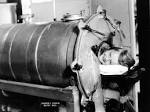
Iron lung |
Iron lung In 1927, the first iron lung (electric respirator) was installed at Bellevue hospital in New York for the post war polio epidemic. The first iron lung was developed at Harvard University by Phillip Drinker and Louis Agassiz Shaw built with two vacuum cleaners. The iron lung is a negative pressure machine which surrounds the patient's body except for the head, and alternates a negative atmospheric pressure with the ambient one, resulting in rhythmic expansion of the chest cage (and thus inhalation) in response to the negative extra thoracic pressure. During periods of ambient extrathoracic pressure, the lungs deflate. This type of machine is rarely used today. |
|
29 Jul 1927

Gerald Westbury |
birth Gerald Westbury Gerald Westbury (died 2014), English cancer surgeon. |
|
29 Jul 1932

Sir William Willcocks |
death Sir William Willcocks Died 29 Jul 1932 at age 79 (born 27 Sep 1852). British civil engineer who proposed and designed the first Aswan (Assuan) Dam (1898-1902) on the River Nile and executed major irrigation projects in South Africa and Turkey. He was born studied engineering in India before moving to Egypt in 1883, becoming director-general of reservoirs. On being asked to find a means of storing Nile water to allow the growth of an extra crop of cotton, he found a depression at Wadi Rayan, into which part of the annual flood waters could be diverted, then fed back into the river in the dry season. When persuaded to build a dam, he designed the Aswan Dam to allow the silt-laden waters of the early weeks of the annual flood to pass through, and only capture for storage the clear water that flowed later in the season. |
|
29 Jul 1947
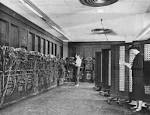
ENIAC |
ENIAC (computer science) After being shut off on November 9, 1946 for a refurbishment, ENIAC, one of the world's first digital computers, is turned on after a memory upgrade. It will remain in continuous operation until October 2, 1955. |
|
29 Jul 1953

Richard Pearse |
death Richard Pearse Died 29 Jul 1953 at age 75 (born 3 Dec 1877). New Zealand inventor and aviation pioneer who at age 21, turned from farming his 100 acres of land, and built a workshop with a forge and a lathe to become an inventor. His first patent was a type of bicycle. By 1902, Pearse had probably built a lightweight two-cylinder engine and first plane out of bamboo, tubular steel, wire and canvas. Accounts of the dates and details of his flights vary because they were not documented, but it is believed that on 31 Mar 1903 he made at least a powered takeoff, though not a controlled, sustained flight, covering perhaps 350 yards before crashing into a tall gorse fence. (It would be the fifth successful powered takeoff in the world.) He made other inventions in his life. Pearse died poor, in a mental hospital. |
|
29 Jul 1958

United States Congress |
United States Congress (astronomy and space ) The United States Congress formally creates the National Aeronautics and Space Administration (NASA). |
|
29 Jul 1960
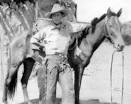
Clyde K.M. Kluckhohn |
death Clyde K.M. Kluckhohn Died 29 Jul 1960 at age 55 (born 11 Jan 1905). Clyde Ray Maben Kluckhohn was an American cultural anthropologist who a deep interest in culture and personality. He chose this profession based on his interest in psychology while at the same time expressing his interest in cultural diversity. He felt that diversities of authentic cultures must be represented in personality psychology. As a professor of anthropology at Harvard University, he contributed to anthropology in a number of ways: by his ethnographic studies of the Navajo; by his theories of culture, partial-value systems, and cultural patterns; by his intellectual leadership and stimulation of a large number of students; and by his representation of anthropology in government circles. |
|
29 Jul 1962

Sir Ronald Aylmer Fisher |
death Sir Ronald Aylmer Fisher Died 29 Jul 1962 at age 72 (born 17 Feb 1890). British statistician, geneticist and evolutionary biologist whose contributions to statistical theory have become mainstays of modern statistical practice. In genetics, he established biometric genetics and studied dominance through breeding experiments with various animals). He developed methods of multivariate analysis to track the linkage of genes for different traits. To avoid introducing bias in the design of experiments that could produce inaccurate or misleading data, he applied his principle of randomization. While continuing his interest in statistics during his university coursework, he began his career as a high school teacher of mathematics (1914-19). During this time he published a paper (1918) applying statistics to yield a fundamental theorem of natural selection. He furthered his study of genetics at Rothamsted Experimental Station as a statistician in 1919. |
|
29 Jul 1982

Vladimir Kosma Zworykin |
death Vladimir Kosma Zworykin Died 29 Jul 1982 at age 92 (born 30 Jul 1889). Russian-American physicist and electronics engineer who is known as “the Father of Television.” Concurrent with the start of radio broadcasting, Zworykin was developing a system of transmitting sound and pictures. Other inventors were using a motorized, mechanical scanning system with rotating disks capable of a picture about one inch square. It was heavy, bulky and impractical for home use. Zworykin, at Westinghouse, instead developed an electronic scanning television system using his innovations, the iconoscope and kinescope, the forerunners of today's television camera. He also invented the electron microscope. |
|
29 Jul 1982
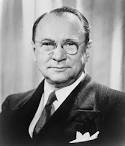
Vladimir K. Zworykin |
death Vladimir K. Zworykin Vladimir K. Zworykin (b. 1889), Russian American pioneer of television technology. |
|
29 Jul 1994

Dorothy Crowfoot Hodgkin |
death Dorothy Crowfoot Hodgkin Died 29 Jul 1994 at age 84 (born 12 May 1910). Dorothy Mary Crowfoot Hodgkin (née Crowfoot) was an English biochemist and X-ray crystallographer, born in Cairo, Egypt to English parents, who was awarded the Nobel Prize for Chemistry in 1964 for her discoveries, by the use of X-ray techniques, of the structure of biologically important molecules, including penicillin (1946), vitamin B-12 (1956), and later, the protein hormone insulin (1969). Her achievements included not only these structure determinations and the scientific insight they provided but also the development of methods that made such structure determinations possible. (One of her students was Margaret Roberts, later Margaret Thatcher, the only British prime minister with a degree in science.) |
|
29 Jul 1994

Dorothy Hodgkin |
death Dorothy Hodgkin Dorothy Hodgkin (b. 1910), British biochemist and winner of the Nobel Prize in Chemistry. |
|
29 Jul 2005

Tenth planet proposed |
Tenth planet proposed In 2005, another candidate for tenth planet was announced by Mike Brown of California Institute of Technology. Its diameter is estimated at 2,100 miles - about 1-1/2 times that of Pluto. Its orbit is eccentric and inclined at about 45 degrees to the main plane of the solar system. It was named 2003 UB313 on a photograph made 31 Oct 2003. Later, its motion was recognized, on 8 Jan 2005. With orbits significantly inclined to the others, the status as a planet of either or even Pluto, is a subject for debate. They are in a region of numerous frozen comet-like objects beyond Neptune - the Kuiper Belt. The object Sedna - somewhat smaller than Pluto - was also found there in 2004. NASA also in an official statement referred to 2003 UB313 as a tenth planet. |